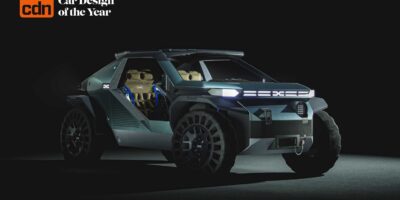At this year’s IAA International Motor Show in Frankfurt, Mercedes-Benz is presenting preproduction models of the new Mercedes-Benz GLC F‑CELL as the next milestone on the road to emission-free driving. Under the technology designation EQ Power, the latest electric model (destined for subsequent series production) from the Mercedes-Benz family is doubly electrifying, for, in a world first, it is set to combine innovative fuel-cell and battery technology in the form of a plug-in hybrid: in addition to hydrogen, the all-electric variant of the popular SUV will also run on electricity. Intelligent interplay between battery and fuel cell, along with short refuelling times, will in future make the GLC F‑CELL a vehicle of high everyday practicality and also suitable for long-distance motoring. With 4.4 kg of hydrogen on board, the preproduction model produces enough energy for a range of up to 437* km in the NEDC. F-CELL drivers will also benefit from a range of up to 49 km in the NEDC thanks to the large lithium-ion battery. An output of 147 kW guarantees both dynamic performance and locally zero emissions driving pleasure. In unveiling the preproduction vehicles of the Mercedes-Benz GLC F‑CELL, Daimler is taking another important step as part of its systematic “CASE” strategy.
Ola Källenius, Member of the Board of Management of Daimler AG, responsible for Group Research & Mercedes-Benz Cars Development, emphasises: “Our many years of experience with fuel-cell technology pay dividends in the new GLC F-CELL: its long electric range, short refuelling times and everyday practicality of an SUV will make it the perfect vehicle. This is made possible by the compact construction of our fuel-cell system. Another genuine world first is the combination with a large additional lithium-ion battery, which can be conveniently charged using plug-in technology.”
Fuel-cell technology is a firm element of Daimler’s powertrain strategy. Under the EQ product brand, the company is pooling its know-how related to intelligent electric mobility while offering a comprehensive e-mobility ecosystem of products, services, technologies and innovations. EQ is therefore a key part of the company’s strategy for the mobility of the future, known at Daimler as “CASE”. The four letters stand for the strategic future pillars of networking (Connected), autonomous driving (Autonomous), flexible use (Shared & Services) and electric drive systems (Electric), which are being systematically further developed and intelligently combined by the company. Between now and 2022, Daimler intends to bring out ten battery-electric vehicles, with the GLC F-CELL representing an important landmark.
Unique: two electric energy sources
The vehicles unveiled at the IAA represent a world first in which a fuel-cell-operated electric car uses a lithium-ion battery as an additional energy source that can be externally charged by means of plug-in technology. Through intelligent interplay, the two energy sources drive the electric motor while offering locally zero emissions driving pleasure. The long range, short refuelling time, an output of 147 kW (200 hp) and the latest generation of assistance systems with powertrain-specific features demonstrate, based on the models on show, that the GLC F-CELL will be a family-friendly electric vehicle of high everyday practicality.
For this world first, the Mercedes-Benz engineers cooperated closely with partners from the Daimler competence network to develop a completely new fuel-cell system. Compared with the B-Class F-CELL, which has been on the market since 2010 (fuel consumption: 0.97 kg H₂/100 km/CO₂ emissions, combined: 0 g/km), the overall drive system offers around 40 percent more output. The fuel-cell system is around 30 percent more compact than before, can for the first time be housed entirely in the engine compartment and is installed on the usual mounting points like a conventional engine. Also, the use of platinum in the fuel cell has been reduced by 90 percent. This conserves resources while lowering the system costs – with no compromises in terms of performance.
The lithium-ion battery in the preproduction vehicles on show has a gross capacity of 13.8 kWh and additionally serves as an energy source for the electric motor. For the first time, it can also be charged externally using plug-in technology. An intelligent operating strategy in combination with the fuel-cell/battery system offers maximum efficiency and comfort. Just like the drive motor, the powerful storage battery is space-savingly installed in the rear of the SUV. By means of the 7.2 kW on-board chargers, it can be conveniently charged from a standard household power socket, a wallbox or a public charging station. The charging time is around 1.5 hours if the full capacity is used.
Two carbon-fibre-encased tanks built into the vehicle floor hold around 4.4 kg of hydrogen. Thanks to globally standardised 700 bar tank technology, the supply of hydrogen can be replenished within just three minutes, which is about the same amount of time it takes to refuel a car with an internal combustion engine.
The F-CELL vehicles on show at the IAA are powered by an asynchronous machine with an output of 147 kW (200 hp) and a torque of 350 Nm. As the electric drive requires no propeller shaft, this makes room for one of the two hydrogen tanks, while the second tank is installed under the rear seat bench.
Coordinated: operating strategy with unique variety of combinations
Like the GLC Plug-in Hybrid, the fuel-cell variant comes with various operating modes and drive programs. The drive programs of the GLC F-CELL will include ECO, COMFORT and SPORT. ECO is optimised for low consumption. COMFORT is geared not only for comfort, but also provides ideal climate control. SPORT optimises the hybrid powertrain for sporty performance.
While the drive programs change the behaviour of the car and therefore the driving experience, the operating modes influence the interplay between fuel cell and high-voltage battery. The combination of drive programs with operating modes is presented for the first time in this form in a fuel-cell vehicle.
Freedom of choice: four operating modes HYBRID – F-CELL – BATTERY – CHARGE
The innovative plug-in fuel-cell powertrain combines the advantages of both emission-free technologies and, thanks to its intelligent operating strategy, constantly ensures that the use of both energy sources is optimally adapted to the particular operating situation.
In HYBRID operating mode, the vehicle draws power from both energy sources. Power peaks are handled by the battery, while the fuel cell runs in the optimum efficiency range. The intelligent operating strategy means that the characteristics of both energy sources can be ideally exploited.
In F-CELL mode, the state of charge of the high-voltage battery is kept constant by the energy from the fuel cell. Driving almost exclusively on hydrogen is the ideal mode if the intention is to keep the electric range in reserve for certain driving situations.
In BATTERY mode, the GLC F-CELL runs all-electrically and is powered by the high-voltage battery. The fuel-cell system is not in operation. This is the ideal mode for short distances.
In CHARGE mode, charging the high-voltage battery has priority, for example in order to recharge the battery for the maximum overall range prior to refuelling with hydrogen. This mode also creates power reserves for uphill or very dynamic driving.
In all operating modes, the system features an energy recovery function, which makes it possible to recover energy during braking or coasting and to store it in the battery.








